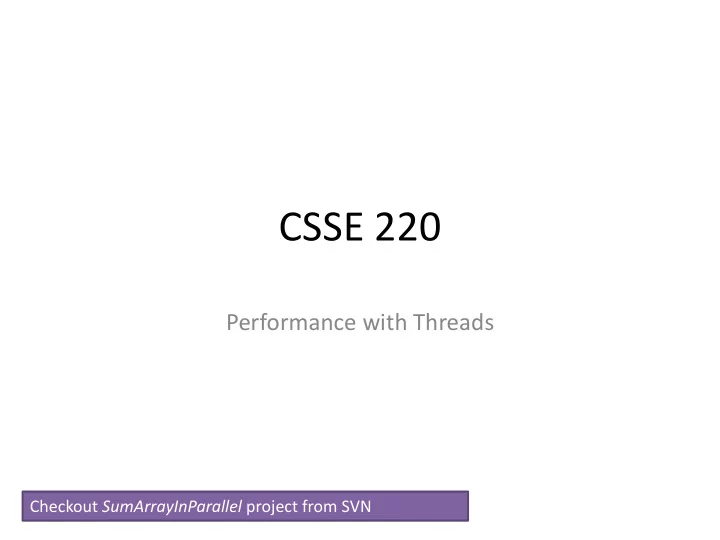

CSSE 220 Performance with Threads Checkout SumArrayInParallel project from SVN
We Used Threads For: • We have used threads for achieving more than one “thing” at a time – Animation – TemperatureMonitor – etc. • What about performance? – Could we not get better performance by creating enough threads to divide work among them on different processor cores?
Conceptually • The concept is pretty straightforward: – Existing Problem: A large task that runs on one core, doing one thing at a time – Running a program in one core on our machines would be roughly as “fast” as running the same program on a processor from 12 years ago! (2004 was the last time Rose had single-core machines) – Modern processors have multiple cores • HOW DO WE TAKE ADVANTAGE OF MULTIPLE CORES??
How occupied are your cores? • Thankfully, Windows allows us to use Resource Monitor to track this • Go to All Programs -> Accessories -> System Tools -> Resource Monitor OR • Press Ctrl-Shift-Esc or Ctrl-Alt-Del on your keyboard, to open the Task Manager. – Then go to the Performance tab and click on the Resource Monitor • Use Overview or CPU tab to monitor CPU usage
Modern Operating Systems • Woo Hoo! • Modern operating systems automatically (more-or-less) send waiting threads to a processor core that is waiting for work • If we write the program to allow the operating system to assign threads to separate cores, then our task (in this class) is just splitting up the work into different threads!
Our Task Today • We want to sum a huge array of integers • Serially, we just add each array element to the current sum and then return the sum when finished • With threads, we can split up the work very easily because of the associative law of addition
The idea • When a very large task can be split into pieces – Assign a thread to one piece and let that thread return its result 12 3 5 44 -86 5 -7 66 9 -74 42 1
The idea • When a very large task can be split into pieces – Assign a thread to one piece and let that thread return its result Thread 3 Thread 1 Thread 2 Thread 4 12 3 5 44 -86 5 -7 66 9 -74 42 1
The idea • When a very large task can be split into pieces – Assign a thread to one piece and let that thread return its result Thread 3 Thread 1 Thread 2 Thread 4 12 3 5 44 -86 5 -7 66 9 -74 42 1 20 -37 68 -31 Add individual portions and return result: 20
The Difference • Conceptually, one core adding 12 numbers serially will “take longer” than 4 cores adding 3 numbers in parallel, then adding those 4 together. • IN REALITY, we need to sum a very large array to see the performance gains in Java since the threads are so heavyweight – We’ll use about 200,000,000 integers in an array!
Work time PRESENTATION IS FRIDAY!!! TEAM PROJECT
Recommend
More recommend